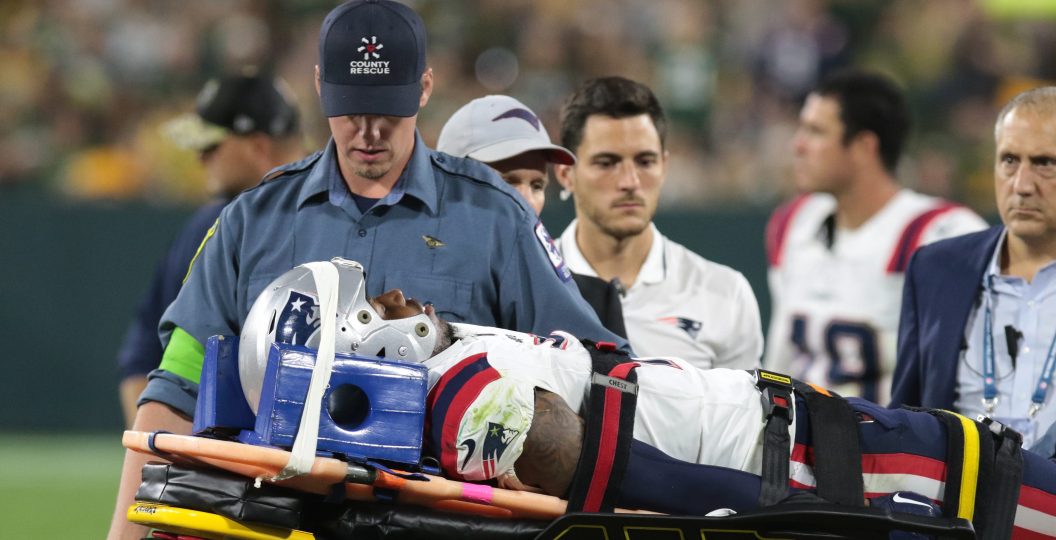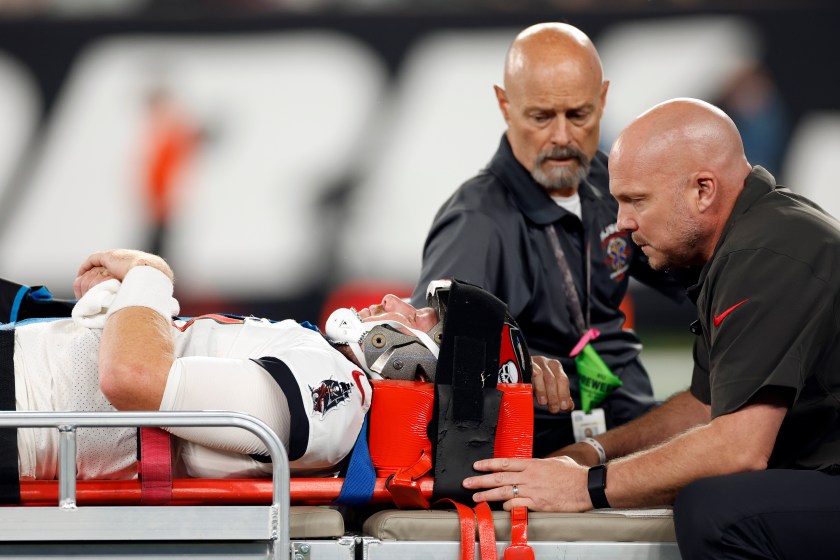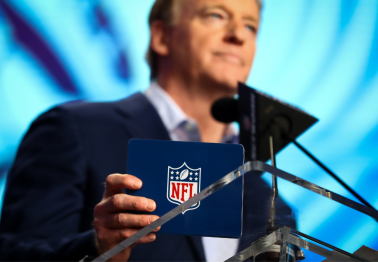The scariest moment in football. Is it a big linebacker coming around the corner untouched and heading for your quarterback? Is it a receiver going over the middle and seeing a linebacker screaming his way just as fast? Is it having to use a porta-john at a Buffalo Bills tailgate?
No. To players and coaches, the scariest moment is when a player doesn't get up after a play. You can see everything pause for a second, and usually one player will begin frantically waving for the medical staff. Teams will kneel down to give some privacy and add some prayer, a ritual of brotherhood we seldom see otherwise. Last year's dramatic cardiac issue with Damar Hamlin was much the same, but the more common issue is a suspected spinal injury. We saw this twice over the past weekend with Tampa Bay Buccaneers quarterback John Wolford and New England Patriots cornerback Isaiah Bolden leaving the game on carts, strapped to boards and collars — and even leading to the suspension of the Pats-Packers preseason game.
It's a scary moment, but it's one that medical staffs prepare for. At lower levels, athletic trainers and EMTs will drill and double-check their procedures. But in the NFL, there's no resource not immediately at hand. The procedures for what to do in these cases is drilled as much as any offensive play; and in each city, the respective medical staffs will meet to discuss all the details and any quirks in what they do.
In the NFL, most teams will bring a cadre of physicians with them, though the home team will always get deference. They know the locations, usually have the same EMT and ambulance throughout a season, and know who'll be receiving the player at the trauma center. NFL teams will also have a list of what family members are on the trip, so they can be transported as well.
FanBuzz spoke with two NFL athletic trainers. Neither was authorized by the team to speak to the media, so I will not name them here. Both told me very much the same thing, as the best practice for management in this situation has become largely standardized by the league.
"The league doesn't have a checklist, but between our association and the NATA (National Athletic Trainers Association, the industry trade group), it's largely the same for every team and every venue," one told FanBuzz. "There's a couple places with quirks, like how they get out of the stadium in a couple, or transferring athletes to the ambulance in the stadiums with grass trays."
Both mentioned that with the two incidents over the weekend, everything went to plan. "It's not preseason for athletic trainers," said one. "We've done that drill over and over, and most staffs don't have a lot of turnover. So it's really years of practice — all the way back to college for me when I first interned with an NFL team."
How NFL Teams Handle Spinal Injuries
Unlike with Hamlin — where the recognition of cardiac arrest required quick, decisive action and application of the defibrillator — spinal or cervical (neck) injuries tend to appear slowly. "What's the racing phrase? Smooth is fast? That's what you want. You have to be smooth with everything, especially with moving the athlete."
Once the medical staff is in place, you will see several of them — including doctors — move into defined roles. The first and most important action is to assess the athlete. "Is he in distress? Is he breathing? Are his eyes open and looking to you?" explained one of the athletic trainers. "You see the fear, but you've also gotten to know this athlete, at least some, in camp. We weigh all our athletes before and after practices for hydration reasons, but that's our chance to put a face to Joe and Bob and vice versa." Both mentioned the fact that most players have that relationship and trust as key to trusting the ATs and following instructions in the moment.
"I carry a tool that pops the facemask off," said one of the ATs, "and once I know that breathing is good, that's my first action. They can see more, they can usually speak more clearly, and they can see me." The head and spine are then stabilized, and the athlete will be rolled slowly so that a spinal board can slide under them. The key is that the spine is held rigid by the staff. In the case of a cervical issue, it's largely done the same, though it's easier to slide a cervical collar underneath the base of the helmet. "We have ones that fit under the helmet. Those have advanced a lot in the last couple years."
Once on the board, the athlete is then lifted onto the gurney. "This is a big deal because these are big men," said one of the ATs. "When we drill, we always try to get the biggest guy on the team to do one of the sessions. It can take six or even eight hands to lift him up smoothly. Dropping him is not an option." One of the ATs said that a team they worked with previously would practice using players as lifters, but they stopped that. "The players aren't trained for this. Yes, they can lift a lot more weight than me, but that might be their friend. It shakes them, and it just didn't seem like the best practice."
Once the athlete is placed on the gurney, in most cases the ambulance will come onto the field to minimize the distance the player has to be moved. However, there are several venues where a cart is used to bring the athlete from the field to where the ambulance is stationed. In either case, one or two of the ATs will be assigned to go with the player. "Again, this is relationship," explained one of the ATs. "This guy is scared. He can't feel his limbs or he was knocked out cold and is altered. He gets a friendly face, one that can talk him through this, end to end."
Both ATs emphasized that role of speaking to the athlete throughout the process is important. "I have to keep my cool despite this being a medical emergency," one explained. "I can't freak out. I can't cry." And the medical staff has to continue its job after the staffer leaves with the ambulance. For that reason, the head athletic trainer is seldom in that role. He or she is in charge of everything on the sideline and the training room on game day, so it's almost always a staffer who leaves with the player. "It changes every year [for my team], depending on seniority and if someone's just better at the role," said one AT.
Once the ambulance is gone, the rest of the medical staff isn't off the hook. Not only does the game go on, there's a bit of shock for the players. "We give them some updates. Even small things like 'He's awake and alert and his wife is with him' reassure them and let them get back to the mentality they need." That's key. One of the athletic trainers said that in one situation, he'd recommended to a coach that a player be pulled. "I saw how much seeing his friend carried off shook him, and I told the coach. They held him out a bit; but, ultimately, it's a football decision and he was needed in a close game."
The overwhelming number of cases where a player is carried off the field will end in a positive outcome. Most are relatively minor — spinal concussions, they are often called — and the player is out of the hospital in days or even less. One of the athletic trainers mentioned Ryan Shazier, a Steelers player who had a severe spinal contusion that necessitated surgery. In that case, the actions of the medical staff in those first golden moments created the possibility that the damage was mitigated and stabilized. Shazier was walking again in months and is the perfect example of why each medical staff works so hard to make sure they get this right.
Both ATs also mentioned that while this is the procedure at NFL and college football, it's not likely that high school or lower levels will have the same care. "Half of all high schools have an athletic trainer, let alone a whole team of them," one explained, and that stat is correct. The last check by the Journal of Athletic Training in 2021 had 37 percent of high schools in the U.S. having a full-time athletic trainer. While most states require an EMT at football games, as many spinal injuries happen at practice. If your son (or daughter) plays football at any level, you should ask what the plan is for a spinal or cervical injury.
The next time a player goes down and you see the medical staff spring into action, you'll know what's happening behind the curtain of players. The work, dedication and drilling of all the medical staff often will lead to that scary moment becoming the start of the recovery.


